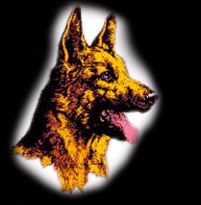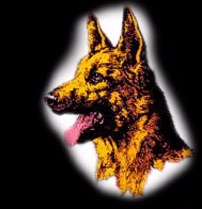the 39th Scout Dog Platoon | home
WW II
the 39th Scout Dog Platoon
123rd Infantry Regiment
33rd Infantry Division
1944-1945



33rd Infantry Division patch
The 39th Infantry Scout Dog Platoon
After training in the California desert, the 123rd Infantry regiment of the 33rd Infantry Division made an interim stop in Hawaii. The 33rd Division's first combat task was at Morotai in New Guinea. Elements of the 33rd valiantly fought and secured Morotai before the landing on Luzon in February, 1945. When the 139 days of combat were over for the 33rd on Luzon, 339 of its men had been killed, 1274 wounded in action, 319 injured, and three listed as Missing in Action.
"More than 200 combat patrols during the period from March 9th to May 23rd, 1945... More than 200 known enemy killed by patrols after advancing into areas alerted by dogs... Any number of times, parties were saved from ambush by the alertness of the dogs and their handlers..."
Thus runs the citation of the 39th Infantry Scout Dog Platoon, made by the 33rd Division, one of the four divisions with which that platoon served in the Philippines
Two deaths in action, one of a handler and one of a dog, also stand on the 39th's Roll Of Honor.
When an assault patrol was given the mission of locating and destroying an enemy machine gun nest, Sergeant Knisely and his German Shepherd, Danny, took the point. Twice the dog alerted, and scouts went forward but were unable to spot the well hidden nest. Then the handler volunteered to lead the patrol as close as possible. Slowly and cautiously they moved up. Danny alerted very strongly, and the sergeant pointed out the gun's exact position. But in the fight that eliminated it and its crew, Knisely was killed. He was awarded the Silver Star posthumously.
Wolf, another shepherd, was leading an infantry patrol through the Corabello Mountains toward the strategic Belete Pass, when he scented a Jap party entrenched on a hill about one hundred and fifty yards distant. The patrol launched a surprise attack. In the hot engagement that followed, Wolf was severely wounded by shell fragments. Since he never whimpered or showed signs of pain, the men around him failed to notice that he had been hit. As the firing increased in intensity, the Americans realized they were heavily outnumbered and were being encircled. Again the dog, and his handler took post at the point. Three times Wolf's alerts enabled the patrol to avoid Jap columns closing in on it. Wounded though he was, Wolf finally guided the American troops out of the trap and back to their command post. When the gallant animal's wounds were discovered, an emergency operation was performed but could not save him.
Another 39th K-9 hero was Bruce. During a screaming Jap banzai attack on E Company, 27th Infantry, the German Shepherd sighted three Japs with fixed bayonets bearing down on a foxhole in which two wounded American soldiers lay. Bruce rushed out in a fierce charge that routed the Japs and saved the wounded men.
Duchess, #7H74: was also a member of the 39th Infantry Scout Dog Platoon. On April 30th, 1945 Duchess handled by Sgt. Knight, on patrol with the 3rd Battalion, 123rd Infantry, was used in the inspection of enemy cave installations on Luzon in the Philippines. On approaching a large one, the dog was permitted to go to the entrance. At this point she gave a strong alert. Grenades were thrown into the cave, after which the patrol moved on. Investigation the following day revealed 33 Japanese dead in the cave. On another occasion Duchess and Sgt. Knight were on patrol with the same unit. Duchess alerted on some Filipino huts, 800 yards away. Closer investigation of the patrol disclosed the presence of the Japs. Mortar and machine-gun fire were used to kill 9 Japanese.
Of interest to historians, the 33rd Division, including it's attached units like the 39th Scout Dog Platoon, was slated to be one of the units spearheading the invasion of the Japanese mainland . The 33rd Division was ordered to prepare for OPERATION OLYMPIC, the invasion of the Japanese home islands to begin on November 1, 1945. The 33rd was scheduled to be in the first wave of the invasion forces and planners estimated that the 33rd Division would suffer 80 to 90% casualties. Fortunately, the Japanese surrendered after the cities of Hiroshima and Nagasaki were bombed with atomic weapons, abruptly ending the war. The 39th would have been in the middle of it all.
When the war ended, the 33rd Division embarked for Japan where it was deactivated in early 1946.
|